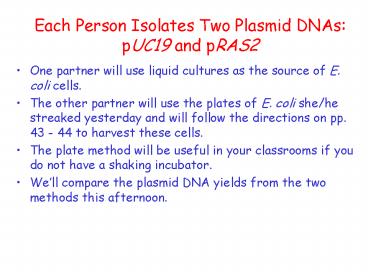Each Person Isolates Two Plasmid DNAs: pUC19 and pRAS2 PowerPoint PPT Presentation
1 / 14
Title: Each Person Isolates Two Plasmid DNAs: pUC19 and pRAS2
1
Each Person Isolates Two Plasmid DNAspUC19 and
pRAS2
- One partner will use liquid cultures as the
source of E. coli cells. - The other partner will use the plates of E. coli
she/he streaked yesterday and will follow the
directions on pp. 43 - 44 to harvest these cells. - The plate method will be useful in your
classrooms if you do not have a shaking
incubator. - Well compare the plasmid DNA yields from the two
methods this afternoon.
2
Everyone Isolates Both Plasmid DNAs Today!
3
Harvesting E. coli from Plates
- Add 3 ml LB liquid medium to the surface of each
of the 2 plates you streaked yesterday
(JM101/pUC19 JM101/pRAS2). - Flame your glass spreader in ethanol, touch it to
a bare region of one plate, and use it to gently
scrape the cells from the surface. - Transfer 1.0 ml of cells to 2 ml tube with a
sterile transfer pipet. Use pipet to pump the
solution up and down to break up clumps. - Put a blue dot on the tube of JM101/pUC19 and a
yellow dot on the tube of JM101/pRAS2. Clean
spreader and repeat with other strain. - Begin DNA isolation procedure at step b p. 45.
4
Prepare an Agarose Gel
- 1. Everyone should pour a gel as you have done
before. - 2. As time allows, overlay the gel with TAE
buffer after it solidifies. - 3. Pull the comb about a minute after you overlay
the gel with TAE. - 4. You will stain with Methylene blue today.
5
Properties of pUC19
- Origin of replication (ori)
- Ampicillin gene (Amp) for selecting
cells/colonies that carry plasmid - LacZ gene for identifying clones with inserted
fragments - Polylinker (21 RE sites)
- 50 - 100 copies/cell
Ampr
LacZ gene
Ori
6
Preparation of RE Digests
- pUC19 (for cloning)
- Digest with EcoRI only as described on p. 47!
- Prepare a small sample from this digest to run on
your agarose gel as described on p. 49. - You will use pUC19 for cloning genomic DNA
tomorrow.
- pRAS2 (for RE mapping)
- Prepare undigested control as on p. 48.
- Prepare 5 digests as described on p. 48.
- Use your data from electrophoresis to make a
restriction map of pRAS2
7
Making Your Restriction Digests
- Add H2O first.
- Add 10 X buffer second.
- Add DNA third and flick the tube to mix.
- Add the restriction enzyme last, flick to mix
again and spin in the microfuge for a few seconds.
8
Preparation of Gel Samples
- pUC19
- After digesting with EcoRI, incubate digest at
65o C 10 min. Why? - Prepare a small sample from this digest add 3 µl
digest to 17 µl H2O and 2 µl loading dye as
described on p. 49. Label this tube 7. - Return the rest of this digest to the box on
front bench.
- pRAS2
- Add 2 µl loading dye directly to each of your 5
digests, flick to mix and spin as described on p.
50. - Load 20 µl of each sample into Lanes 1 - 6 of
your gel.
9
Finish todays experiment by running, staining
and photographing your gel with Methylene Blue as
usual.
10
Single Restriction Enzyme Digests
- In single digests, the DNA is cleaved by only one
restriction enzyme. - You can determine the number of sites that enzyme
has in the DNA being studied from the number of
bands visible after electrophoresis. You can also
determine the relative orientations of the sites
from the sizes of the bands.
11
Multiple Restriction Enzyme Digests
- In multiple digests, the DNA is cleaved by more
than one enzyme. - From the single digests, you know how many sites
are present for each enzyme (and the relative
orientations of the sites). So, you can predict
how many sites should be present in the multiple
digests. - From the multiple digests, you can determine the
orientation of the sites produced by different
enzymes relative to one another from the sizes of
the DNA fragments produced after gel
electrophoresis. large
three medium-sized bands
small
12
Cloning Your Genomic DNA into pUC19
- In experiment 4, you will use both the genomic
DNA and the pUC19 DNA you isolated and digested
with EcoRI earlier this week. Transparency - Tonight you will incubate these two DNAs with DNA
ligase, which forms phosphodiester bonds between
different DNA molecules. - Tomorrow you will transform your ligated DNA into
the E. coli strain JM101.
13
Preparing a JM101 Plate (Wed.)
- Everyone should prepare a plate of JM101 for
making competent cells tomorrow by streaking
JM101 from the original stock plate you worked
with Monday to an LB plate and incubating at 37o
C overnight. - The streak you make today should be relatively
dense, so follow the directions on p. 53 of your
manual.
14
Preparation of Ligation Mix (Wed.)
- Speak with Karen or a member of the lab staff to
determine which of your genomic digests to use.
They should resemble smears if they are well
digested. See suggestions on p. 54. - If your pUC19 DNA is fully digested, it will be a
single band slightly smaller than 3 kb. - If youre uncertain about either type of DNA,
discuss this with Karen or a member of the lab
staff. - Everyone should prepare a ligation mix as
described on p. 55.

